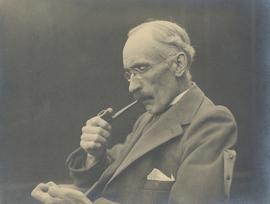- GB/NNAF/P147009
- Person
- 1875-1956
Born Dumfriesshire 1875; died Edinburgh 1956
William Wright Smith graduated MA from Edinburgh University in 1896 and, with a teaching diploma from Moray House, taught in Edinburgh schools for 6 years while developing an interest in natural sciences. He lectured at Edinburgh University in advanced botany between 1902 and 1907 before being appointed keeper of the herbarium at the Royal Botanic Garden, Calcutta in 1907. The following year he became acting superintendent with responsibilities including the Botanic Garden in Darjeeling and the quinine factory at Mungpoo. Smith spent 4 years in India, officiating as Director of the Botanical Survey of India, plant collecting in the remoter regions of the Himalayas up to 14,000 ft. and gaining a wide knowledge of the flora of India, the Himalayas and Burma. In 1911 Sir Isaac Bayley Balfour appointed him Deputy Keeper of the Royal Botanic Garden, Edinburgh, a post he held until Bayley’s retirement in 1922 when he succeeded to the dual post of Regius Keeper of the Garden and Regius Professor of Botany at the University. During the Second World War Wright Smith’s work for the timber supply department stimulated his interest in forestry and through his links with the newly formed Forestry Commission he was responsible for establishing the first specialist garden of the Royal Botanic Garden at Benmore on the Cowal Peninsula, a site suitable for rhododendrons and conifers. Wright Smith also made considerable contributions to taxonomy specialising in Sino-Himalayan plants, particularly Primula and Rhododendron. Known for his ‘homely’, humorous and kindly disposition, Wright Smith received many honours during his long career. On the occasion of his 70th birthday he was presented with two portraits, one by Stanley Cursiter RSA. He was knighted in 1932 and held the post of Keeper for 34 years until his death in 1956.
Sources: R. Desmond ‘Dictionary of British and Irish Botanists and Horticulturalists); HR Fletcher and WH Brown ‘The Royal Botanic Garden Edinburgh 1670-1970’; Deni Bown, ‘4 Gardens in One’; press cuttings
D.W.

